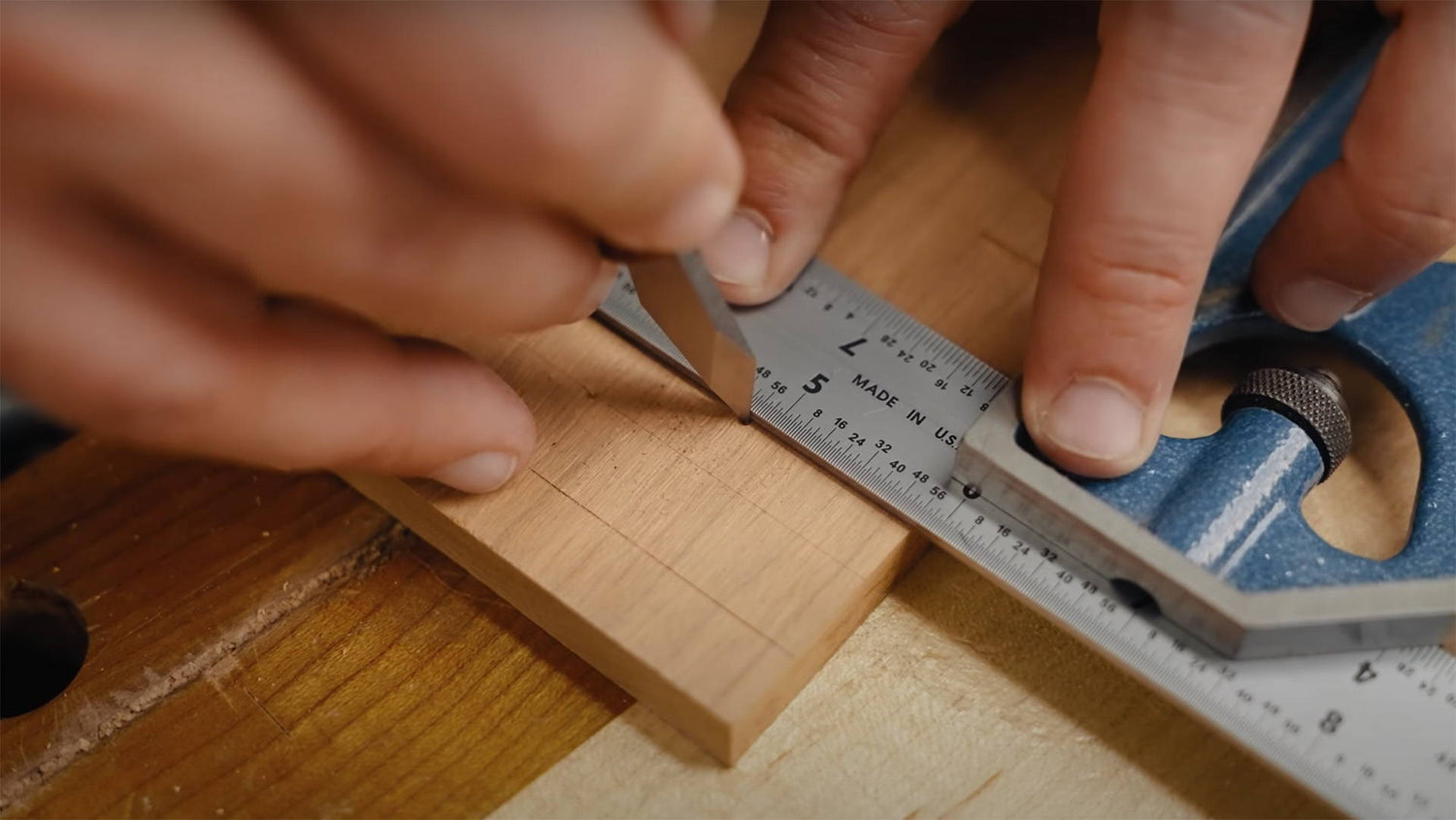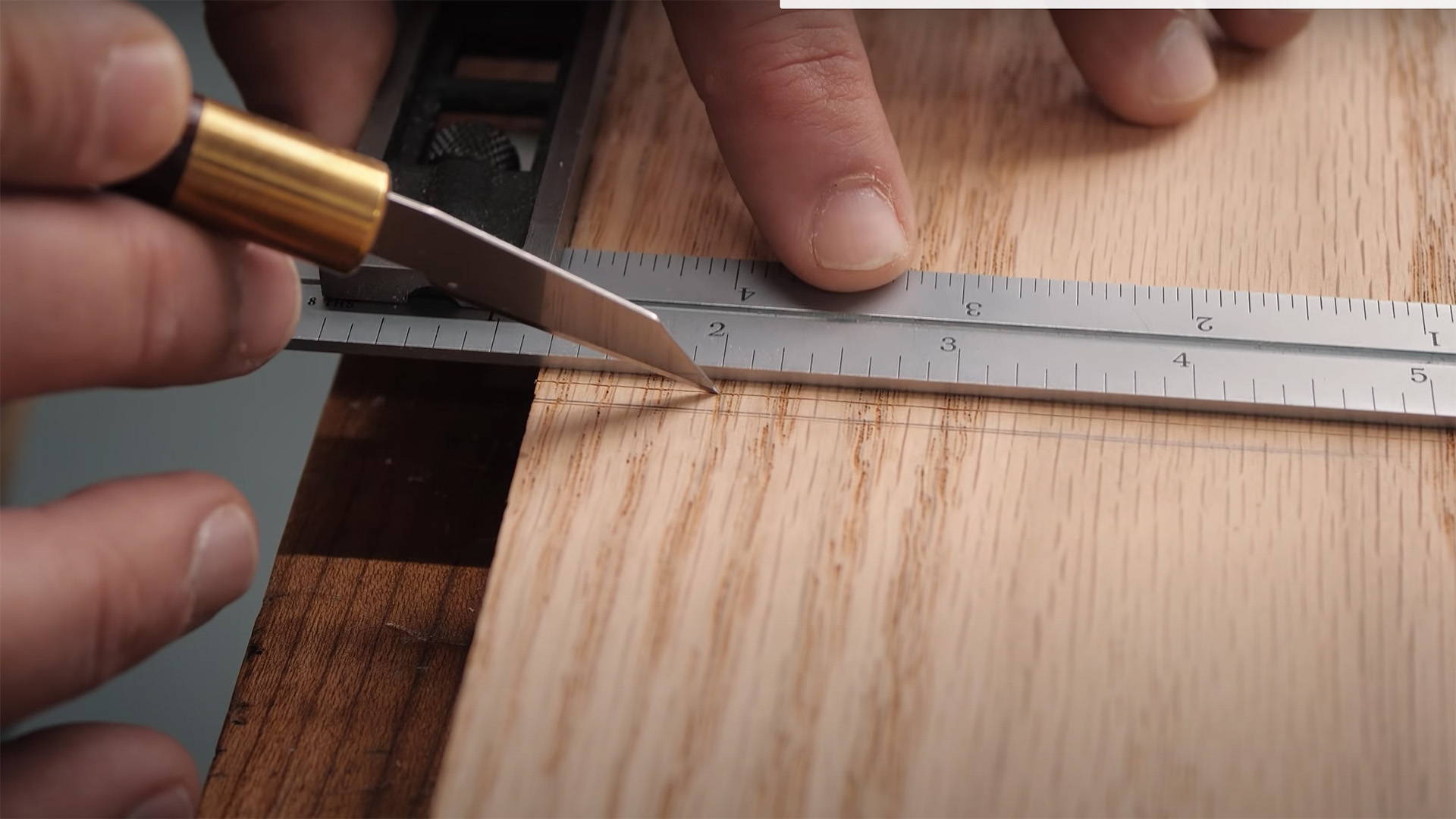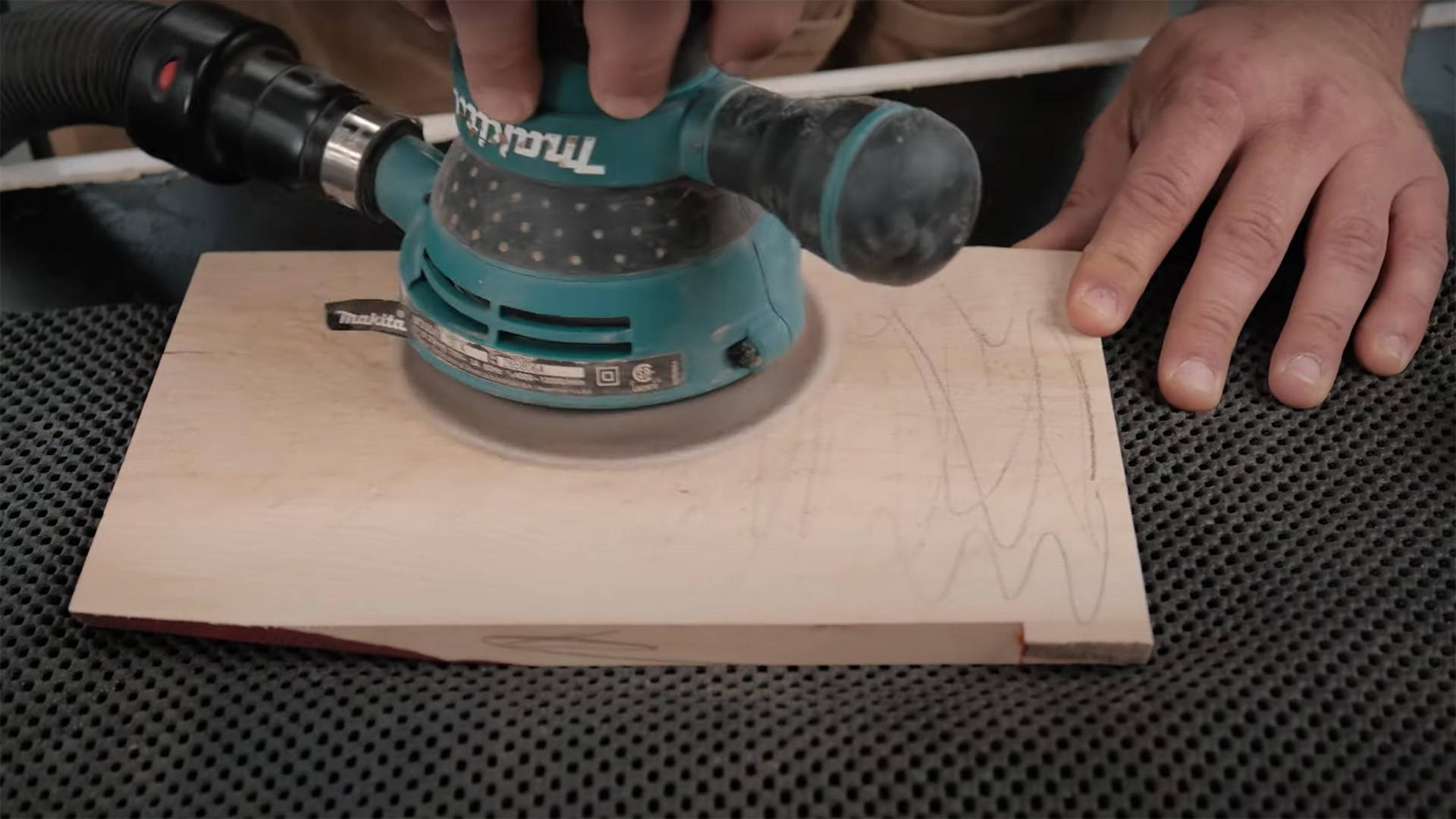For beginners, diving into the world of woodworking tools is like stepping into a labyrinth of a hardware store.
It's easy to get lost in the aisles, unsure of where to begin.
That's why understanding the basic tools you need for fine furniture-making is so crucial.
In this guide, I walk you through a checklist of “essential” tools for beginner woodworkers.
(No tool is truly essential... but work with me here).
My hope is that it makes your initial steps into the world of woodworking a lot less daunting…
So you can spend more time building — and less time wondering what you need.
DISCLAIMER: GET TOOLS AS YOU NEED THEM
There’s no one-size-fits all toolkit for every woodworker.
The right tools for you depend on the style of woodworking you primarily do.
But the best tool buying advice I’ve ever heard is “only buy the tools you need.”
When a need arises, get the tool for the job. But don’t buy tools just because you think you might have a use for them down the road.
So while the following checklist can give you guidance, don’t think you need to get every tool on this list all at once.
MARKING AND MEASURING TOOLS
In woodworking, precision is the key to success.
You don’t need to be a machine. The tolerances of woodworking are forgiving.
But using the right marking and measuring tools will go a long way in improving your accuracy right from the start
MARKING KNIFE OR PENCIL
The first tool you need is something for “layout” — which are marked lines for planning cuts. The two common choices are a marking knife or pencil.
To me, it’s like choosing between a scalpel and a crayon.
Don’t get me wrong. There are a ton of incredibly skilled woodworkers that use pencil for layout.
It’s versatile, familiar, and allows you to make clear visible lines on the wood's surface. Which is why I prefer it for rough layout.
But pencil lines have a degree of thickness that can impact the precision of your cuts.
A marking knife, on the other hand, leaves behind an indentation that acts as a guide for your saws, chisels, and power tool blades.
That difference alone makes marking knives invaluable for elevating your accuracy right from the start.
Need a marking knife? Check out this double-bevel marking knife.
SQUARE / BEVEL GAUGE
Squares and bevel gauges are like seeing eye dogs for your marking knife:
They ensure your layout lines are exactly 90° (square) or at whatever angle you choose..
There are several types of squares: combination squares, try squares,machinist squares. Any kind works.
Combo squares are great because their interchangeable fences let you use them as a 90° and 45° square, protractor, and level.
A bevel gauge can also be super useful for laying out less common angles (though if you have a combo square with a protractor fence, you don’t really need one).
Need a simple square? Check out these 4” and 6” machinist squares.
MARKING GAUGE
A marking gauge lets you mark lines at a set distance from a reference edge.
There are several types to choose from.
Wheel marking gauges have a small wheel blade that cuts a really clean line. These are my favorites.
Pin marking gauges scribe lines with a thin nail head. They can be super affordable, but I find they tend to leave a rougher line.
Regardless of the type you choose, a marking gauge is essential if you plan on learning joinery techniques.
(This is my favorite marking gauge — complete with a micro-adjust mechanism for ultra-accuracy).
TAPE MEASURE
No shop is complete without at least one tape measure (I have more than I can count).
One tip though: While building a project, use the same tape measure the whole time.
Even slight discrepancies between different ones can lead to problems with your final product.
HAND TOOLS
Even in a power-tool dominated shop, hand tools offer an irreplaceable level of control.
They let you tackle operations that might not be possible or safe with power tools…
And while you could get by without the following tools, I recommend every beginner woodworker learn how to wield them effectively.
CHISELS
Chisels are ideal for fine tuning joinery — letting your sneak up on perfect fits
I recommend starting with a basic set of four chisels including ¼”, ½”, ¾”, and 1” wide blades.
These sizes cover a variety of common woodworking tasks, from fine detail work to serious chopping.
MALLETS AND HAMMERS
Mallets and hammers are the driving force behind your chisels, nails, and dowels.
They’re also a big help in knocking joints together and assembling projects.
Different mallets and hammers have different intended purposes — so read this to understand which ones you’ll need.
HAND SAWS
Even if you own a circular saw or table saw, hand saws are a must-have.
They let you make quick and dirty cuts with minimal setup — but also let you tackle intricate cuts that would be difficult or unsafe to execute on power tools.
To start, I recommend getting a rip saw and a dovetail/crosscut saw (you can get both here).
BLOCK PLANE
Block planes are a fantastic first hand plane for beginner woodworkers.
They let you flush trim proud joinery, quickly soften sharp board edges, and get you acquainted with how hand planes work.
I prefer low angle block planes since they’re more effective for cutting end grain.
SHARPENING TOOLS
If you own chisels or hand planes, you need a way to keep them sharp.
Sharpening stones, strops, and honing guides let you do it.
When you’re just getting started, I recommend checking out The Scary Sharp System. It’s the most affordable setup to get into sharpening and lets you hone crazy sharp edges.
Along with that, a sharpening jig makes it easier to sharpen at precise and consistent angles.
HANDHELD POWER TOOLS
Handheld power tools can often substitute for large stationary tools — which saves you a lot of money as you’re first getting started.
They’re also ideal for working with big unwieldy boards and plywood panels.
Here are the handheld power tools I’d first get as a beginner:
CIRCULAR SAW OR TRACK SAW
Circular saws, or skill saws, are what to grab when you need straight cuts.
They’re an excellent choice for breaking down large sheets of plywood or creating precise lengths of lumber.
It takes a bit of setup to make sure your cuts are square. But it’s doable.
Track saws are the upgraded version of circular saws that include a track for the saw to ride on, ensuring your cuts are super straight and accurate.
They’re more expensive than circular saws, but can help you stave off buying a table saw for a while.
POWER DRILL OR DRIVER
Power drills are essential for drilling holes and driving fasteners.
With a set of forstner bits, they can also be great for dowel joinery and clearing waste for mortises.
It’s hard to drill holes as precisely as a drill press — but there are “power drill press” attachments that can help.
JIGSAW
The jigsaw is the go-to handheld power tool for making curved cuts — which can add a ton of possibilities to your woodworking.
(They’re also great for breaking down lumber).
Bandsaws are obviously superior at the job. But with a careful hand and the right setup, you can put off buying a bandsaw for a long time with a good jigsaw.
RANDOM ORBITAL SANDER
The random orbital sander is the key to achieving smooth surfaces on your final piece.
It's designed to move in both a circular and orbital motion, minimizing swirl marks and ensuring an even finish.
Any type of power sander can work — but I truly think random orbital sanders are best.
(Of course, you’ll also need sandpaper. And we carry the best sandpaper in our store).
ROUTER
Routers are ridiculously versatile tools. And they can truly open up worlds for your woodworking.
Edge profiles, template routing, inlay and joinery work: with a few router bits, the possibilities are endless.
If you’re on a budget, I’d start with a compact or trim router (you can see which one I recommend here).
But if you’ve got a little more to invest, a full-size router around 2 hp will let you make bigger cuts.
STATIONARY POWER TOOLS
Stationary power tools are the backbone of a well-equipped woodworking shop — and offer a level of precision and efficiency that take your projects to new heights.
They’re more of an investment. But if you’re serious about woodworking, they’re worth it.
Here are the essential stationary power tools every beginner should consider:
TABLE SAW
The table saw is the undisputed beating heart of most woodshops.
It provides unparalleled precision for making straight cuts. And with the addition of sleds and jigs, can be used for all sorts of joinery and shaping operations.
The thing is, they get expensive.
Jobsite saws are a good place to start. And as my friend Tamar from 3x3 Custom has proved, they CAN be used for fine furniture making.
Once you develop your skills, you’ll know when it’s time to move up to a bigger table saw.
Just make sure you understand table saw safety before using one.
PLANER
Planers are one of those tools that really only does one thing — but are pretty much essential.
What they do is “thickness” boards, making one board face flat and parallel to the opposite face.
Usually, you’d need a jointer to flatten the first face. But there’s a trick to flatten both faces with just a planer.
One of the big differences between fine woodworking and DIY is working with truly square boards…
And a planer is a must-have to square up lumber efficiently.
SAFETY GEAR AND PPE
Safety should always be your top priority while woodworking.
Between spinning blades and lung-shredding sawdust, a lot can go wrong.
That’s why having the right safety gear and PPE is essential.
SAFETY GLASSES
Safety glasses shield your eyes from flying debris, wood chips, and dust.
They’re especially important with power tools, where chips or entire boards can suddenly shoot at your face faster than you can blink.
If you need some, check out these safety glasses that do NOT fog up.
HEARING PROTECTION
Woodworking tools are LOUD.
And over time, extended exposure can lead to hearing damage.
Ear protection, in the form of earmuffs or earplugs, is a simple yet critical addition to your safety gear.
DUST MASK AND RESPIRATORS
Wood dust poses serious respiratory hazards (just watch this).
Dust masks filter out the most dangerous fine particles, ensuring you breathe clean air in the workshop.
They also save you from a noseful of wood-boogers.
If you’re using finishes that contain VOCs (volatile organic compounds), it’s also important to wear a good respirator.
ASSEMBLY AND FINISHING TOOLS
Cutting and shaping boards is just the beginning of a project.
It ain’t finished until you put all the pieces together and make it shine.
Here are the essential assembly and finishing tools every beginner woodworker should have in their arsenal.
WORKBENCH
A workbench is your command center for woodworking (and I probably should have mentioned it earlier in this blog post).
It provides a stable and level surface for assembling and finishing your projects.
A well-designed workbench offers a range of clamping options, like vises, holdfasts, and the like.
Here are plans for my mini-joinery workbench I use in all my videos. It’s a great option to get you started.
We also have plans for a low workbench that’s great for hand tool work.
CLAMPS
Clamps are the extra set of hands you wish you had.
They come in various types, from squeeze and F-style clamps to pipe and parallel clamps, each serving specific purposes
WOOD GLUE
If you want to get into joinery — where boards are connected without any fasteners like screws or nails — you’ll get to know wood glue.
It forms strong, durable bonds that hold your projects together… and modern wood glues are known for being stronger than wood itself.
FINISH AND APPLICATORS
Applying a finish is the final step in any woodworking project, and it's what brings out the natural beauty of the wood.
There’s a lot of finish types out there. And each has its own application process.
I recommend trying different finishes and finding your favorite (Rubio Monocoat has recently usurped the throne for my favorite finish).
Need finishing supplies? Check ‘em out here.
LET IT BEGIN
Armed with these essential tools, you're ready to dive head-first into the world of woodworking.
Remember, your tool needs aren’t particular to YOU — so purchase tools as you need them.
And most importantly, don’t forget to enjoy the satisfaction of creating furniture with your own hands!
Not sure which trim router to buy? Read this.
What would be the first tools you’d recommend to a beginner woodworker? Let me know in the comments below!
Follow us on Instagram @katzmosestools, on TikTok @katzmoseswoodworking, and check out my YouTube channel for more great woodworking content...
And as always, STAY SAFE IN THE SHOP!











4 comments
woodworking tool auctions
Thank you for allowing me to express my thoughts on your post. Every blog you write is done so well. I would also like to add some more details I have found on website https://www.auctionmasters.com/industries/woodworking-cabinet-shop
Thank you for allowing me to express my thoughts on your post. Every blog you write is done so well. I would also like to add some more details I have found on website https://www.auctionmasters.com/industries/woodworking-cabinet-shop
Steve Winslade
Hi Jonathan can I ask what size you would recommend for what would be my first block plane. I’ve never used one and not sure what one I would need but my biggest problem is holding it as my hands turn 90 degrees outwards so quite a few things are harder to hold than others.
Many thanks steve👨🏼🦽
Hi Jonathan can I ask what size you would recommend for what would be my first block plane. I’ve never used one and not sure what one I would need but my biggest problem is holding it as my hands turn 90 degrees outwards so quite a few things are harder to hold than others.
Many thanks steve👨🏼🦽
woodworkersshoppe
Woodworking is a captivating and hands-on craft that involves transforming raw pieces of wood into functional or decorative items using various tools and techniques. It’s not just about building furniture; it’s a dynamic blend of creativity, precision, and problem-solving.
Woodworking is a captivating and hands-on craft that involves transforming raw pieces of wood into functional or decorative items using various tools and techniques. It’s not just about building furniture; it’s a dynamic blend of creativity, precision, and problem-solving.
Dusty Deryck
No message
No message